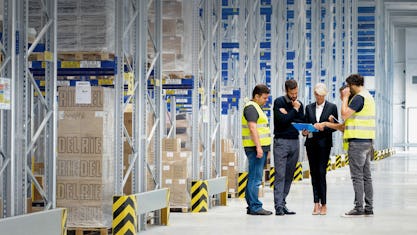AI for process optimization in the manual warehouse
AI applications such as digital value stream mapping, process mining and motion mining can be used in almost all areas of intralogistics to optimise workflows.

Due to the rapid development of artificial intelligence (AI) and cyber-physical systems, process optimisation is increasingly taking place via AI. Process optimisation is the task of analysing workflows, documenting them, uncovering weaknesses and developing an improved workflow. In addition to smoother processes and improved quality, cost savings can be a further goal (1).
Process optimisation using Big Data and AI
There are many possible applications for optimising processes and workflows in a manual warehouse. Classic methods include value stream mapping, process mapping, total quality management, LEAN, Kaizen, Six Sigma, and 5S/5A. In the context of digitalisation, however, new developments such as digital value stream mapping, process mining or motion mining are increasingly gaining ground. With the help of these applications, a large amount of data can be collected digitally, which means it can no longer be evaluated and interpreted manually using classic methods. AI solves this challenge. With the help of big data analysis, structures and dependencies in the data can be recognised and identified, which give the planner, in addition to those responsible for operations, a variety of targeted options for action to optimise processes.
What is Artificial Intelligence?
According to Britannica, artificial intelligence (AI) is "the ability of a computer or a robot controlled by a computer to do tasks that are usually done by humans because they require human intelligence and discernment.” AI has already entered countless industrial, technical, and social domains. There are a constantly growing number of sub-disciplines of artificial intelligence, which now include: bots, predictive maintenance, data mining, process mining, neural networks, machine learning, deep learning, and many more. Deep learning with the help of neural networks is currently the most promising approach in artificial intelligence as well as within machine learning.
Explaining further, Britannica says that “artificial intelligence and machine learning are not the same, but they are closely related. Machine learning is the method to train a computer to learn from its inputs but without explicit programming for every circumstance. Machine learning helps a computer to achieve artificial intelligence”.
Many possible uses for AI applications
There are possible uses for AI applications such as the aforementioned process mining and motion mining in almost all areas of intralogistics. Examples include in-plant transport (forklifts and other industrial trucks, as well as continuous conveyors), process analyses with corresponding performance and quality data, and motion analyses during picking and packing. Another essential aspect, in addition to the identification of quality defects and ‘waste’, is the improved ergonomic design of work processes. For this purpose, a virtual model of a warehouse is usually created. With the help of this ‘digital twin’, simulations of warehouse workflows and processes can be carried out to optimise storage locations.
What is process mining?
Process mining (2) is a combination of the terms ‘process management’ and ‘data mining’. It offers the possibility to examine business processes and warehouse operations and to identify potential for optimisation. Data mining algorithms are used to examine large volumes of data (what is often called ‘big data’) for specific patterns. This means real processes are analysed on the basis of information from event logs from IT systems using algorithms. Processes that can be examined and optimised in an organisation through process mining include manufacturing, supply chain and sales.
There are three types of process mining techniques: Discovery, Conformance, and Enhancement. Discovery involves analysing and recognising processes and creating digital models of the processes. Conformance enables an assessment of the conformance of existing process models to current data. In other words, existing process models are validated and compared with new data. Finally, enhancement is used to extend existing process models.
In contrast to conventional process analysis methods, process mining is holistic. This means that the interrelationships and dependencies of all business and warehouse processes are included – processes are therefore represented in their entire complexity. Process mining distinguishes itself from classical techniques for the creation of process models by a high degree of automation. Process flows, costs and throughput times can be represented in detail and transparently using a wide range of visualisation options. This give the advantage allowing changes to be reacted to quickly and efficiently and any problems that may arise can be anticipated in the future. Sources of problems and deviations also become visible through process mining. Never more so than In the digital age of Industry 4.0 and Logistics 4.0, companies have to adapt their processes flexibly and optimally again and again in order to remain competitive. Through process mining, a company gains insight into how its business processes work and can locate any potential for improvement. Process mining is considered a key technology for creating a digital twin of a warehouse or an entire company (3).
Motion mining for efficiency and ergonomics
Motion mining technology (4) can be used to automatically, efficiently and anonymously record data and optimise manual work processes in terms of their ergonomics and efficiency, in a wide range of applications. These include logistics and supply chains as well as intralogistics. To record data, warehouse employees can be kitted with wearable technologies, such as mobile sensors, on their wrists and belts. Thanks to the integrated sensors, movements during individual work processes can be precisely recorded and detected. All work processes can be carried out comfortably and without hindrance by the wearables.
In order to analyse the human-technology interaction more precisely, equipment such as transport devices or forklifts can also be additionally fitted with special sensors. With the help of miniature radio transmitters with an integrated power source, often known as ‘beacons’, employees and activities can be localised. The advantage of the beacons is that they can be installed quickly and easily in the respective process areas. Measuring equipment detects the radio signals of the transmitters and thus calculates current location, similar to GPS. Since all measured values (activity and localisation data) are always collected without employee reference, the scope of the GDPR is not impacted.
The enormous amount of data collected is automatically analysed by AI. The assignment of activities and process steps is carried out via a specially developed pattern recognition procedure based on deep learning. This works by AI independently recognising the various workflows or process components, such as waiting time, travel time or handling time. The integrated recognition catalogue includes many different activities and can be supplemented with new activities as needed. Thanks to the ergonomics analyses, unhealthy bending processes, overhead work or walking distances can also be analysed. In addition, the technology also offers location-specific analyses, activity indicators and the evaluation of vehicle and assistive device use. The analyses can be presented as key figures or in numerous formats such as pie charts, bar charts, boxplot charts and heat maps. It is also possible to carry out statistical evaluations over a certain period of time and thus quantify expenses or fluctuations. In combination with data from the Warehouse Management System (WMS), a reference to the production program can also be established. In general, motion mining can be used to optimise workflows (ergonomics and efficiency), collect valid data, perform measurements without IT integration, ensure data anonymity and save time and costs.
Literature:
1 BITO Expertise, Process Optimisation in Production Logistics, Link
2 BITO Expertise, Process Mining optimises business processes, Link
3 Scurry Maria, How Process Mining Enables the Digital Twin of an Organisation (DTO), Link.
4 Motion-Mining®, Automated and anonymous analysis and optimisation of manual processes, Link


